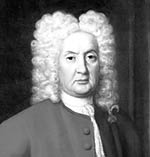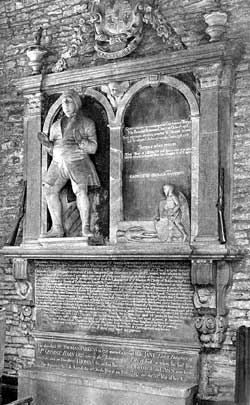
Sir Thomas Parkyns (1663-1741).
The second Baronet, Sir Thomas Parkyns, became a noted man in his day. He seems to have combined much culture and philanthropy with great devotion to the science and art of wrestling. The large and remarkable mural monument at the N.E. end of the chancel was erected by him during his lifetime. There are two compartments to this strange monument. In the left Sir Thomas is represented in a wrestling posture, and in the right compartment he appears as having been "thrown" by Time. The sculpture is said to have been the work of his chaplain, while the Latin inscription was written by Dr. Friend, Master of Winchester School, where Sir Thomas, as a boy, was educated. The inscription is in hexameter and pentameter lines, and runs thus:—
Quem modo stravisti longo in certamine, Tempus, Hic recubat Britonum clarus in orbe ; fugit Hinc primus stratus; praeter te vicerat omnes ; De te etiam victor, quando resurgit, erit. Throsby, in his additional notes to Dr. Thoroton's history, is very indignant that a monument of this character should find a place in the chancel of a church; and in this respect he has given utterance to the feelings of many other persons besides himself; but Throsby emphasizes the pugilistic character of the inscription by writing "pugil" for "fugit," and entirely disregards the Christian hope and belief expressed in the fourth line. The following may be given as an English rendering of the inscription:— Only now in lengthened fight, hast thou thrown, O Time One who here reclines, illustrious in the British ring; Hence he flees, first thrown; yet all but Thee he'd conquered; And e'en from Thee, when again he rises, will he bear the palm.

The Parkyns monument in Bunny church.
Sir Thomas took a pride in styling himself "Luctator," and wrote a treatise on wrestling, called "Inn Play; or Cornish Hugg Wrestler. Digested in a method which teacheth to break Holds, and throw most Falls Mathematically," dedicating the book to King George I. His wrestling ground was in the garden of what is now the "Rancliffe Arms," He added vastly to the estate by purchasing the Manors of Ruddington, Great Leake, Costock, Wysall, Thorpe, Willoughby, with parts of Keyworth, Barrow-upon-Soar, and Gotham. He also restored the Hall, enclosing the park with a wall, three miles in circumference, and built to a great extent on arches; a method that was new in England. He put a new roof on the chancel of Bunny Church, built a new Vicarage ; built and endowed the Free School at Bunny with the four almshouses adjoining; he also built the hunting tower on Bunny Hill, and planted woods ; and in public matters relating to the town and county of Nottingham always took an active part. In 1741, he died at the age of 78, having lived in the reigns of James II., William and Mary, Queen Anne, George I., and George II. He was succeeded by Sir Thomas Parkyns, third baronet, who died in 1806, and was twice married, (i) to his great niece Ann Parkyns, by whom he had Thomas Boothby Parkyns, and (2) to Jane Boultbee, by whom he had Thomas Boultbee Parkyns, the father of Mr. Mansfield Parkyns, of Woodborough. Colonel Thomas Boothby Parkyns was M.P. for Leicester in 1790 and in 1796; and as he died in 1800, before his father, he never succeeded to the baronetcy. But in 1795 for some reason or other he was made an Irish peer, with the title of Baron Rancliffe.
His son, Sir Thomas George Augustus Henry Anne Parkyns, succeeded to the peerage of Rancliffe on the death of his father in 1800, and to the baronetcy on the death of his grandfather in 1806. This second Lord Rancliffe may be remembered by some of the older members of the Thoroton Society as a prominent Whig politician, who at one time represented Nottingham in Parliament. He died in 1850, without issue, and alienated the Bunny estates from the family, bequeathing them to Mrs. Harriet Forteath. The peerage therefore became extinct and the baronetcy passed to his first cousin, Sir Thomas George Augustus Parkyns, fifth baronet, the son of Thomas Boultbee Parkyns, who at one time lived at Ruddington. He died in Italy."
To the above history of the Parkyns family, it may be well, while dealing with it to give the following additional facts.
The name Parkyns, or Perkins in its more modern form, is a derivative of Peter or Piers, and the Bunny family traces its descent from Peter Morley, alias Perkins of Shropshire, "servus" or bailiff of the estates of Hugh Despencer (1380). The grandson of this man was John Perkyns, who held lands at Madresfield in 1393, and had a son William who became lord of Ufton Robert in 1411, and a grandson Thomas Parkyns, who having two sons, divided his estates between them; bequeathing Ufton Robert to his eldest son John, and Madresfield to the younger son Thomas. The Parkyns of Notts, are descended from this younger son Thomas Parkyns of Madresfield, in Worcestershire.
The arms of the Parkyns of Notts, were originally the the same as the Ufton shield, "or, a fess dancette between "ten billets ermines," but in 1559 Richard Parkyns, of Madresfield, obtained a grant as follows:—Arms, "Argent, an eagle displayed sable, in a canton golde, a fesse dauncette, between seven billettes sable, on eche an erminey." Crest—"on a wreath argent and sable a pine apple braunche verte, the aple in his proper couller mantled gules, double argente."
Judged from an "Introduction to the Latin tongue" which Sir Thomas the wrestler wrote for his grandson and the school at Bunny, his classical scholarship cannot have been otherwise than indifferent; and the book can never have been revised by his old master of Westminster, Dr. Friend. Among the rules for syntax is given the extraordinary one that after such verbs as 'see,' 'hear,' 'think,' 'know,' 'believe,' 'wonder,' 'hope,' 'promise,' 'rejoice,' 'shew,' 'say,' or their contraries 'quod' should be used! ' I go to see ' is prosed as ' eo videre;' and 'I will wait till the master comes' as 'manebo dum magister venit'!
Another interesting member of this family deserves mention, viz., the late Mr. Mansfield Parkyns, of Woodborough, who was the second son of Thomas Boultbee Parkyns, and the younger brother of Sir Thomas George Augustus Parkyns, fifth baronet. He was educated at Woolwich and Trinity College, Cambridge. His residence at Cambridge was not continued beyond his first year as a freshman. This fact seems to have been due to his great and possibly inherited keenness for the "Britonum orbem." He was a first-rate boxer as his great-grandfather had been a first-rate wrestler. But this keenness for the art of self-defence was not found compatible with a study of mathematics; so "Alma mater" was left behind for a nine years' tour in the East. No news of Mr. Parkyns reached England during this long period of absence, but at the end of it he returned to Europe and was appointed attache to the British Embassy at Constantinople. Returning to England about 1852, he wrote his "Life in Abyssinia." His travels had embraced Abyssinia, Nubia, Sennar, Kordofan, and Egypt; and throughout these countries, at that time comparatively unknown to Europeans, he had lived with the natives, adopting their customs and dress. He married the Hon. Emma Louisa Bethell, third daughter of Richard, first Baron Westbury, who died in 1877, leaving eight daughters. He was made official assignee to the Court of Bankruptcy at Exeter and the Comptroller in London, but retired in 1884. The last years of his life were spent in great retirement at Woodborough, and to a large extent in genealogical and artistic pursuits ; the last work of his life being the carving of the beautiful oak choir stalls in Woodborough Church, which were dedicated to the memory of his wife on Christmas Eve, 1893. Cholera, dysentery, and the hardships of his nine years' travels had severely weakened his constitution, and he died January 12, 1894, after a few days' illness.
